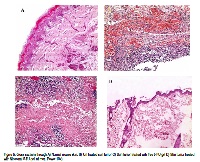Niosomal 5-Flourouracil gel for effective treatment of skin cancer; In-vitro and In-vivo evaluation
Keywords:
5-Flourouracil, niosomal gel, skin cancer, transdermal permeation, niosomesAbstract
This study was designated to form core-enriched 5-flourouracil (5-FU) niosomes and apply it to skin as a niosomal gel for topical treatment of skin cancer. Different molar ratios of the two surfactants used namely; sorbitan monostearate (Span 60), sorbitan monolaurate (Span 20) to cholesterol were employed, in addition; sodium deoxycholate was used a co-surfactant. The drug was successfully entrapped in niosomes with entrapment efficiency reached up to 67.08 ± 2.53 mg % (w/w). The produced niosomes had particle size below 300 nm, zeta potential values between -15 ± -1.6 and - 37.73 ± -2.53 mV and polydispersity index between 0.09 ± 0.06 and 0.20 ± 0.02. Transmission electron microscopy showed the formation of spherical niosomes with closed bilayer structure. Formula N8 had more than two fold increase in amount permeated compared to free drug in in-vitro permeation study. The niosomal gel formulae had better permeation parameters compared to formulae containing free drug. Niosomal gel formula composed of sodium carboxymethyle cellulose (Na CMC) had the best permeation parameters among the produced gel formulae. Histopathological studies showed that niosomal 5-FU gel was able to penetrate more readily into deep layers of skin to treat tumor as indicated by the reduction in inflammatory reaction and hemorrhage signs observed in animals treated by niosomal 5-FU gel.
References
. Ahmed S, Stewart JH, Shen P, Vontanopoulos KI, Levine EA. Outcomes with cytoreductive surgery and HIPEC for peritoneal metastasis. J Surg Oncol. 2014; 110 (5) 575-584
. Cheung-Ong K, Giaever G, Nislow C. DNA-damaging agents in cancer chemotherapy: serendipity and chemical biology. Chem Biol. 2013; 20 (5): 648-659.
. Gross K, Kircik L, Kricorian G. 5% 5-Fluorouracil cream for the treatment of small superficial basal cell carcinoma: efficacy, tolerability, cosmetic outcome, and patient satisfaction. Dermatol Surg. 2007; 33(4): 433-440.
. Van Ruth S, Jansman FG, Sanders CJ. Total body topical 5-fluorouracil for extensive non-melanoma skin cancer. Pharm. World Sci. 2006; 28 (3): 159-162.
. Morse LG, Kendrick C, Hooper D, Ward H, Parry E. Treatment of squamous cell carcinoma with intralesional 5-fluorouracil. Dermatol. Surg. 2003; 29(11): 1150-1153.
. Zhang N, Yin Y, Xu SJ, Chen WS. 5-fluorouracil: mechanisms of resistance and reversal strategies. Molecul. 2008;13(8): 1551-1569.
. Arias JL, Ruiz MA, López-Viota M, Delgado AV. Poly(alkylcyanoacrylate) colloidal particles as vehicles for antitumor drug delivery: A comparative study. Colloids Surf. B Biointerf. 2008; 62(1): 64-70.
. Merino V, L´opez A, Kalia Y, Guy RH. Electrorepulsion versus elctroosmosis: effect of pH on the iontophoretic flux of 5-fluorouracil. Pharm. Res. 1999; 16(5): 758-761.
. Lee WR, Shen SC, Wang KH, Hu C.H, Fang JY. The effect of laser treatment on skin to enhance and control transdermal delivery of fluorouracil. J. Pharm. Sci. 2002; 91(7) 1613–1626.
. Beall HD, Sloan KB. Topical delivery of 5-fluorouracil (5-FU) by 1,3-bisalkylcarbonyl-5-FU prodrugs. Int. J. Pharm. 2002; 231(1): 43-49.
. Gao S, Singh J. Effect of oleic acid/ethanol and oleic acid/propylene glycol on the in vitro percutaneous absorption of 5-fluorouracil and tamoxifen and the macroscopic barrier property of porcine epidermis. Int. J. Pharm. 1998; 165(1): 45–55.
. Shakya V, Bansal BK. Niosomes: a novel trend in drug delivery. Int J Res Develop Pharma Life Sci. 2014; 3(1): 1036-1041.
. Balakrishnan P, Shanmuga S, Lee WS, Lee WM, Kim J O, Oh DH, Kim D, Kim J S, Yoo B K, Choi HG, Woo J S, Yong CS. Formulation and in vitro assessment of minoxidil niosomes for enhanced skin delivery. Int. J. Pharm. 2009; 377(1): 1-8.
. Jenning V, Schafer-Korting M, Gohla S. Vitamin A-Loaded Solid Lipid Nanoparticles for Topical Use: Drug Release Properties. J. Contr. Rel. 2000; 66(1): 115-126.
. Paget G, Barnes J. Evaluation of drug activities and pharmacometrics., Lautrance D, Bacharach A, editors, 1st ed., Academic Press, London , New York; 1964. p.135-166.
. Al-Harbi M, Qureshi S, Raza M, Ahmed M, Giangreco A, Shah A. Influence of anethole treatment on the tumour induced by Ehrlich ascites carcinoma cells in paw of Swiss albino mice. Eur. J. Cancer Prevention. 1994; 4(1): 307.
. Gillet A, Grammenos A, Compère P, Evrarda B, Piel G. Development of a new topical system: Drug-in-cyclodextrin-in-deformable liposome. Int. J. Pharm. 2009; 380(1): 174-180.
. Chen Y, Lu Y, Chen J, Lai J, Sun J, Hu F,Wu W. Enhanced bioavailability of the poorly water-soluble drug fenofibrate by using liposomes containing a bile salt. Int. J. Pharm. 2009; 376(1): 153-160.
. Uchegbu IF, Florence AT. Non-ionic surfactant vesicles (niosomes)-physical and pharmaceutical chemistry. Adv. Colloid Interface Sci. 1995; 58(1) 1-55.
. Uchegbu IF, Vyas SP. Non-ionic surfactant based vesicles (niosomes) in drug delivery. Int. J. Pharm. 1998; 172(1) 33-70.
. Honeywell-Nguyen PL, Bouwstra JA. Vesicles as a tool for transdermal and dermal delivery. Drug Disc. Today. 2005; 2(1): 67-74.
. Qureshi S, Al-Shabanah OA, Al-Harbi M, Al-Bekairi AM, Raza M. Boric acid enhances in-vivo Ehrlich ascites carcinoma cell proliferation in Swiss albino mice. Toxicol. 2001; 165(1): 1-11.
. Fecchio D, Sirois P, Russo M, Jancar S. Studies on inflammatory response induced by Ehrlich tumor in mice peritoneal cavity. Inflammation. 1990; 14(1) 125-32.





